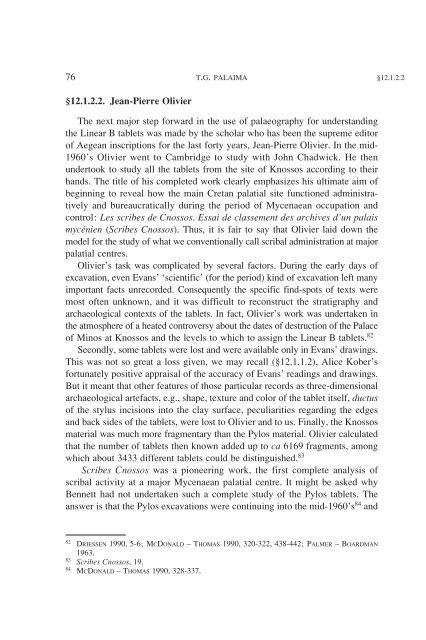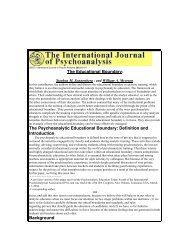A Companion to Linear B - The University of Texas at Austin
A Companion to Linear B - The University of Texas at Austin
A Companion to Linear B - The University of Texas at Austin
Create successful ePaper yourself
Turn your PDF publications into a flip-book with our unique Google optimized e-Paper software.
76 T.G. PALAIMA §12.1.2.2<br />
§12.1.2.2. Jean-Pierre Olivier<br />
<strong>The</strong> next major step forward in the use <strong>of</strong> palaeography for understanding<br />
the <strong>Linear</strong> B tablets was made by the scholar who has been the supreme edi<strong>to</strong>r<br />
<strong>of</strong> Aegean inscriptions for the last forty years, Jean-Pierre Olivier. In the mid-<br />
1960’s Olivier went <strong>to</strong> Cambridge <strong>to</strong> study with John Chadwick. He then<br />
under<strong>to</strong>ok <strong>to</strong> study all the tablets from the site <strong>of</strong> Knossos according <strong>to</strong> their<br />
hands. <strong>The</strong> title <strong>of</strong> his completed work clearly emphasizes his ultim<strong>at</strong>e aim <strong>of</strong><br />
beginning <strong>to</strong> reveal how the main Cretan pal<strong>at</strong>ial site functioned administr<strong>at</strong>ively<br />
and bureaucr<strong>at</strong>ically during the period <strong>of</strong> Mycenaean occup<strong>at</strong>ion and<br />
control: Les scribes de Cnossos. Essai de classement des archives d’un palais<br />
mycénien (Scribes Cnossos). Thus, it is fair <strong>to</strong> say th<strong>at</strong> Olivier laid down the<br />
model for the study <strong>of</strong> wh<strong>at</strong> we conventionally call scribal administr<strong>at</strong>ion <strong>at</strong> major<br />
pal<strong>at</strong>ial centres.<br />
Olivier’s task was complic<strong>at</strong>ed by several fac<strong>to</strong>rs. During the early days <strong>of</strong><br />
excav<strong>at</strong>ion, even Evans’ ‘scientific’ (for the period) kind <strong>of</strong> excav<strong>at</strong>ion left many<br />
important facts unrecorded. Consequently the specific find-spots <strong>of</strong> texts were<br />
most <strong>of</strong>ten unknown, and it was difficult <strong>to</strong> reconstruct the str<strong>at</strong>igraphy and<br />
archaeological contexts <strong>of</strong> the tablets. In fact, Olivier’s work was undertaken in<br />
the <strong>at</strong>mosphere <strong>of</strong> a he<strong>at</strong>ed controversy about the d<strong>at</strong>es <strong>of</strong> destruction <strong>of</strong> the Palace<br />
<strong>of</strong> Minos <strong>at</strong> Knossos and the levels <strong>to</strong> which <strong>to</strong> assign the <strong>Linear</strong> B tablets. 82<br />
Secondly, some tablets were lost and were available only in Evans’ drawings.<br />
This was not so gre<strong>at</strong> a loss given, we may recall (§12.1.1.2), Alice Kober’s<br />
fortun<strong>at</strong>ely positive appraisal <strong>of</strong> the accuracy <strong>of</strong> Evans’ readings and drawings.<br />
But it meant th<strong>at</strong> other fe<strong>at</strong>ures <strong>of</strong> those particular records as three-dimensional<br />
archaeological artefacts, e.g., shape, texture and color <strong>of</strong> the tablet itself, ductus<br />
<strong>of</strong> the stylus incisions in<strong>to</strong> the clay surface, peculiarities regarding the edges<br />
and back sides <strong>of</strong> the tablets, were lost <strong>to</strong> Olivier and <strong>to</strong> us. Finally, the Knossos<br />
m<strong>at</strong>erial was much more fragmentary than the Pylos m<strong>at</strong>erial. Olivier calcul<strong>at</strong>ed<br />
th<strong>at</strong> the number <strong>of</strong> tablets then known added up <strong>to</strong> ca 6169 fragments, among<br />
which about 3433 different tablets could be distinguished. 83<br />
Scribes Cnossos was a pioneering work, the first complete analysis <strong>of</strong><br />
scribal activity <strong>at</strong> a major Mycenaean pal<strong>at</strong>ial centre. It might be asked why<br />
Bennett had not undertaken such a complete study <strong>of</strong> the Pylos tablets. <strong>The</strong><br />
answer is th<strong>at</strong> the Pylos excav<strong>at</strong>ions were continuing in<strong>to</strong> the mid-1960’s 84 and<br />
82<br />
DRIESSEN 1990, 5-6; MCDONALD – THOMAS 1990, 320-322, 438-442; PALMER – BOARDMAN<br />
1963.<br />
83 Scribes Cnossos, 19.<br />
84<br />
MCDONALD – THOMAS 1990, 328-337.

















